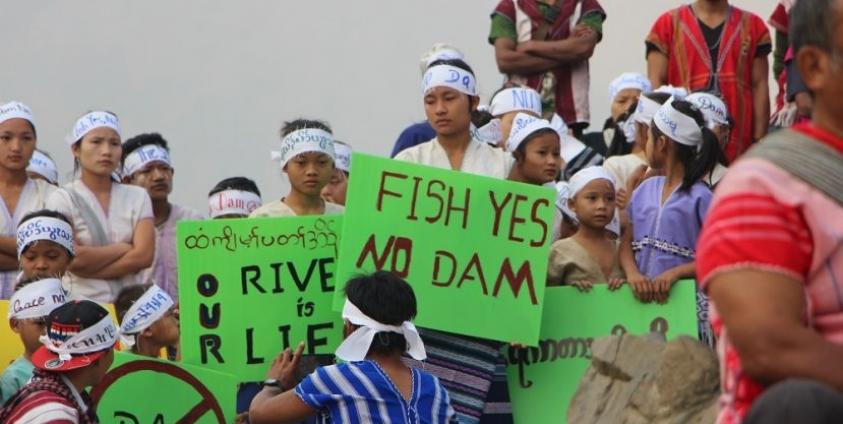As the Karen National Union prepares to elect a new leadership body this week, displaced Karen families joined a local environmental group in lobbying for the next chairperson to reject hydropower proposals.
On March 14, International Day of Action for Rivers, Karen Rivers Watch held a demonstration on the bank of the Salween. Members of the Ee Tu Htat and Uweklo internally displaced persons (IDPs) camps attended the event, which was held near Uweklo village.
“We want the elders of the KNU who will be elected at the 16th congress to reject dam projects. If the new Karen leaders change their minds [to allow the dams] the decision will neglect the needs of the local people and leave us very worried,” said Sa Tu Tu Sten, one of the event leaders.
The three-week KNU Congress, which is currently meeting in Hpa-An district, will elect leadership and establish a four-year agenda. But neither of the two anticipated frontrunners, the current chair, General Mutu Say Poe and vice chair Padoh Naw Zipporah Sein, have expressed much support for large-scale, foreign-funded hydropower developments. However, General Mutu Say Poe has said smaller projects intended to benefit local villagers could proceed if they have the support of residents.
At least two major hydropower dams and several smaller projects have been planned for Kayin (Karen) State’s portion of the Salween River, Southeast Asia’s longest undammed river. China is pushing to develop the 1,3000 megawatt Hat Gyi dam in Kayin State. The project, which is expected to flood two forest reserve areas, would export the electricity generated to Thailand.
Sa Tu Tu Sten said that the Myanmar and Thai governments should not be discussing hydropower dams in areas of armed conflict since disagreements over who controls the natural resources can fuel further fighting and threaten the peace process. According to some analysts and observers, tensions over the giant Myitsone hydropower dam in Kachin State helped propel the end of the Kachin Independence Army’s ceasefire and resumption of fighting in 2011. The Karen Rivers Watch blamed the Hat Gyi dam for provoking fighting between the Tatmadaw and the DKBA last year.
Sa Tu Tu Sten added that large hydropower projects also risk fueling further displacement in a state that has already seen tens of thousands of villagers expelled from their homes and land.
At the March 14 demonstration, IDPs of all faiths joined in prayers to protect the people from any disadvantageous dams.
“We’d like to demand the soon-to-be elected Karen leaders to decisively defend the local people and take responsibility to rule out the dam projects,” said Naw The Nae, chair of the Karen Women’s Organization chapter in the Ee Tu Hta IDP camp.
Lieutenant General Saw Baw Kyaw Heh, vice commander-in-chief of the Karen National Liberation Army – the KNU’s armed wing, said last year that a pragmatic approach must be taken toward hydropower dams.
“I cannot demand myself that the dam projects do not go ahead. But as we are an organization to protect the Karen people, we must proceed in activities that are in accordance with the wishes of the Karen people,” he said.
Edited by Laignee Barron








